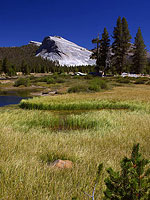
Dispersed camping is a great way to avoid the potential pitfalls of campgrounds (photo courtesy of PDPhoto.Org)
One of the great joys of camping is getting away from it all and spending some quality time with your family. That’s hard to do, though, when the guy in the next campsite is running a generator all night, or having the equivalent of a frat party next door.
When you really want to ensure a peaceful and serene camping experience, dispersed camping is the way to go. The US Forest Service and BLM generally allow camping anywhere on undeveloped public lands, with a few provisions:
- Camping at any one site is limited to 14 days per visit
- Pack out what you pack in
- Avoid camping within 200 feet of any water source
- Do not leave campfires unattended
The downside of dispersed camping, of course, is that there are no signs to tell you where to go to find those great camping spots. You are on your own, when it comes to discovering camping spots on undeveloped public lands. If you are unfamiliar with the area, try camping in a designated campground first, so that you can scout the area for future dispersed camping spots.
For a little bit of extra trouble, however, dispersed camping offers some huge advantages over camping in a campground. Noise pollution is nowhere to be found and you will likely have and entire area to yourselves.
There are few extra considerations if you plan to try dispersed camping. No designated campground means no campground facilities such as toilets, drinking water, picnic tables, and fire rings.
Practice good leave no trace principles by camping on a durable surface, keeping your campfire small (or avoid a campfire altogether), use biodegradable soap, and pack out all trash and leftover food.
If you are looking for a little peace and quiet on your next family camping adventure, give dispersed camping a try. It will probably ruin you for ever camping in a managed campground again, but that is a small price to pay for the enjoyment and serenity of having an entire forest to yourself.
See also…

Comment commander des bitcoins pas cher via le net sans risque
Here is my web-site litecoin
Pourquoi acheter bitcoin sans
trace sur une cb facilement
tout pour se procurer litecoin sans trace par des sites internet
en 5 minutes
my web site :: bitcoin
Comment acheter des btc via le réseau internet en anonyme
Also visit my web-site acheter litecoin
Heya i am for the first time here. I came across this board
and I find It truly useful & it helped me out much. I hope to give
something back and help others like you aided me.
my blog – acheter bitcoin
Hey Joshua, I’d just give the Angeles National Forest office a ring at (626) 574-5200 and ask them. You also have Cleveland National Forest down by San Diego, and the San Bernardino out east. Click on the US Forest Service link (“Find a Campground”) and use the “By State” drop-down on their home page.
Wow! This sounds great, but how do you find out where “undeveloped public lands” are? If I drive around my Los Angeles hinterlands I can find plenty of national forests, but they always seem to either be locked up, regular campgrounds, or posted no-camping spots. Where does one find these magical Xanadu’s?
Roy, I’m talking about the USFS maps you buy at ranger stations. They’re not topo maps; they are essentially road maps that show important features in the forest, such as lakes, mountains, campgrounds, and trails. That said, the Forest Service also creates topo maps of popular hiking areas, such as Desolation Wilderness and Mokelumne Wilderness in the Sierra Nevada.
I have Topozone software for topo maps. It gives me all the topo maps in California. (I have to print ’em out myself.)
Jim – that sounds like a great place! I have yet to run into any bears or mountain lions here in the Bay Area, but the place is thick with mountain lions. There’s a lot of food, though, so I think that keeps them busy.
John – do you get your maps from USGS? I’ve only got 1:300,000 right now, which are totally inadequate for anything other than locating public lands, themselves. You really need 1:24,000 when you are “on the ground.”
Roy, I’ve camped a lot in my life, but rarely in campgrounds. I almost always go find my own spot alone in the wilderness, just as you suggest.
It is very helpful to have the US Forest Service maps for a given forest. They show all the roads. By looking at the USFS map and the terrain as you are actually driving, you can figure out where possible level spots will be.
Roy, one other thing about camping on undeveloped BLM or Forest Service land is that you may have to have a spark emitter safety guard on your vehicle. Some of the BLM land I have camped on does have a sign at the main entry point warning of this and you have to go to the nearest BLM ofice to get a pass after your vehicle has been checked out. This is mainly for fire safety on open range lands.
There is one particular place I have been to and it is Powell Lake in the hinterlands of Utah. There is a very nice small lake filled with trout for all you avid flyfishermen and it also has a campground too. The fee is modest and there is water and latrines available. Your only concern would be mountain lions and bears as it is THEIR territoy.